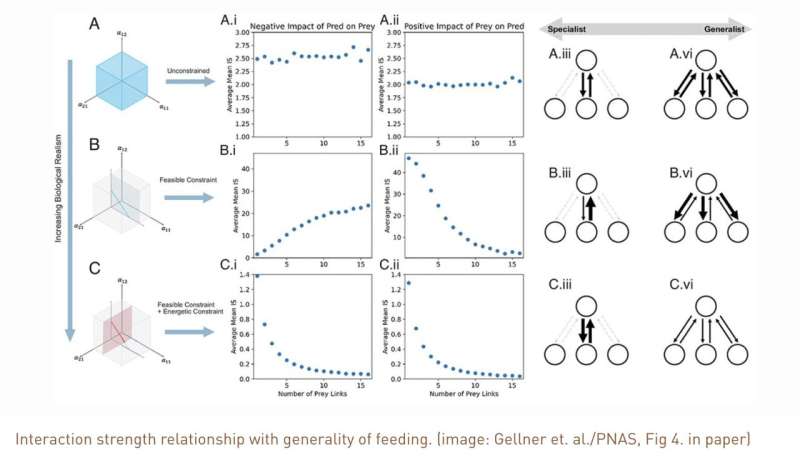This article has been reviewed according to Science X's editorial process and policies. Editors have highlighted the following attributes while ensuring the content's credibility:
fact-checked
peer-reviewed publication
trusted source
proofread
Study: An inverse model for food webs and ecosystem stability

In a new study published in the Proceedings of the National Academy of Sciences, authors Gabriel Gellner and Kevin McCann from the University of Guelph and SFI External Professor Alan Hastings (UC Davis) invert a classical approach to modeling food webs. Instead of trying to replicate stable, complex ecosystems using simplistic representations of species interactions, the authors' novel inverse method assumes the ecosystems exist and works backward to characterize food webs that support that assumption.
Their work represents a significant step toward addressing a fundamental ecological question of how biodiversity promotes ecosystem stability. The findings offer insights into how nature may respond to growing anthropogenic disturbances.
"Rather than start with what's hard to measure—how species affect each other—we start with how many of each species there are and figure out how they interact in a way that explains their coexistence," says Hastings.
Earth's ecosystems display surprisingly stable dynamics, but attempts to understand that stability have flummoxed ecologists for generations. Lord Robert May, a past Chair of the SFI Science Board, drew from economic theory to introduce the community matrix, a mathematical tool to describe the relationships of species in an ecosystem.
The matrix uses species interactions as a foundation to explain the role of diversity and complexity in ecosystem stability. The approach is useful because it considers all food web interactions; it comes up short because doing so requires overly simplistic assumptions about how organisms relate to each other. Many models based on this technique show stability decreasing as biodiversity increases, which contradicts observable stable ecosystems.
But understanding how large complex ecosystems persist is a vital question. If we fail to understand the mechanisms that stabilize ecosystems, we cannot preserve them in the face of ever-increasing chaos like severe weather events, rampaging wildfires, or rampant invasive species.
The inverse approach succeeds due to its inclusion of biological constraints in the model. A feasibility constraint dictates that only real interactions get represented in the model. Additionally, an energetic constraint stipulates that a meal cannot yield more energy than the hunt requires because, in a food chain, only 10-20% of a resource's energy transfers to the consumer.
"We see lots of diverse ecosystems out in the world," says Hastings. "We showed that if you put the proper biological information into the model, we can simulate large, diverse ecosystems and understand why they are stable."
The authors highlight that the inverse approach offers major theoretical advantages over May's classical approach, introduced more than 40 years ago. "While Robert May's approach operated with a statistical universe…, the inverse approach has the novel property that it allows us to only look at the collection of webs corresponding to realistic feasible solutions."
May's community matrix catalyzed ecological theory for nearly half a century. Just as May drew from economics to rethink diversity–stability relationships, Hastings and his co-authors draw on recent efforts in genomics for inspiration. The authors believe their inverse approach is, likewise, "rich in potential for theoretical advances."
More information: Gabriel Gellner et al, Stable diverse food webs become more common when interactions are more biologically constrained, Proceedings of the National Academy of Sciences (2023). DOI: 10.1073/pnas.2212061120
Journal information: Proceedings of the National Academy of Sciences
Provided by Santa Fe Institute


















